


Joint Strike Fighter (JSF)

| On October 26, 2001, the Defense Department selected Lockheed Martin's F-35 as the winner of the competition to manufacture the Joint Strike Fighter. Click here for more information. |
The Joint Strike Fighter (JSF) is a multi-role fighter optimized for the air-to-ground role, designed to affordably meet the needs of the Air Force, Navy, Marine Corps and allies, with
improved survivability, precision engagement capability, the mobility necessary for future
joint operations and the reduced life cycle costs associated with tomorrow’s fiscal
environment. JSF will benefit from many of the same technologies developed for F-22 and
will capitalize on commonality and modularity to maximize affordability.
The 1993 Bottom-Up Review (BUR) determined that a separate tactical aviation modernization program by each Service was not affordable and canceled the Multi-Role Fighter (MRF) and Advanced Strike Aircraft (A/F-X) program. Acknowledging the need for the capability these canceled programs were to provide, the BUR initiated the Joint Advanced Strike Technology (JAST) effort to create the building blocks for affordable development of the next-generation strike weapons system. After a review of the program in August 1995, DoD dropped the "T" in the JAST program and the JSF program has emerged from the JAST effort. Fiscal Year 1995 legislation merged the Defense Advanced Research Projects Agency (DARPA) Advanced Short Take-off
and Vertical Landing (ASTOVL) program with the JSF Program. This action drew the United Kingdom (UK) Royal Navy into the program, extending a collaboration begun under the DARPA ASTOVL program.
The JSF program will demonstrate two competing weapon system concepts for a tri-service
family of aircraft to affordably meet these service needs:
USAF-Multi-role aircraft (primarily air-to-ground) to replace F-16 and A-10 and
to complement F-22. The Air Force JSF variant poses the smallest relative engineering
challenge. The aircraft has no hover criteria to satisfy, and the characteristics and handling qualities associated with carrier operations do not come into play. As the biggest customer for the JSF, the service will not accept a multirole F-16 fighter replacement that doesn't significantly improve on the original.
USN-Multi-role, stealthy strike fighter to complement F/A-18E/F. Carrier operations account for most of the differences between the Navy version and the other JSF variants. The aircraft has larger wing and tail control surfaces to better manage low-speed approaches. The internal structure of the Navy variant is strengthened up to handle the loads associated with catapult launches and arrested landings. The aircraft has a carrier-suitable tailhook. Its landing gear has a longer stroke and higher load capacity. The aircraft has almost twice the range of an F-18C on internal fuel. The design is also optimized for survivability.
USMC-Multi-role Short Take-Off & Vertical Landing (STOVL) strike fighter to
replace AV-8B and F/A-18A/C/D. The Marine variant distinguishes itself from the other variants with its short takeoff/vertical landing capability.
UK-STOVL (supersonic) aircraft to replace the Sea Harrier. Britain's Royal Navy JSF will be very similar to the U.S. Marine variant.
The JSF concept is building these three highly common variants on the same production
line using flexible manufacturing technology. Cost benefits result from using a flexible manufacturing approach and common subsystems to gain economies of scale. Cost commonality is projected in the range of 70-90 percent; parts commonality will be lower, but emphasis is on commonality in the higher-priced parts.
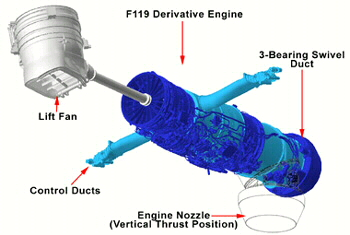 |  The Lockheed Martin X-35 concept for the Marine and Royal Navy variant of the aircraft uses a shaft-driven lift-fan system to achieve Short-Takeoff/Vertical Landing (STOVL) capability. The aircraft will be configured with a Rolls-Royce/Allison shaft-driven lift-fan, roll ducts and a
three-bearing swivel main engine nozzle, all coupled to a modified Pratt & Whitney F119 engine that powers all three variants. The Lockheed Martin X-35 concept for the Marine and Royal Navy variant of the aircraft uses a shaft-driven lift-fan system to achieve Short-Takeoff/Vertical Landing (STOVL) capability. The aircraft will be configured with a Rolls-Royce/Allison shaft-driven lift-fan, roll ducts and a
three-bearing swivel main engine nozzle, all coupled to a modified Pratt & Whitney F119 engine that powers all three variants.
|
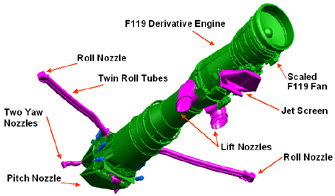 | 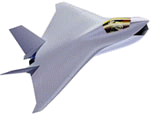 The Boeing X-32 JSF short takeoff and vertical landing (STOVL) variant for the U.S. Marine Corps and U.K. Royal Navy employs a direct lift system for short takeoffs and vertical
landings with uncompromised up-and-away performance.
The Boeing X-32 JSF short takeoff and vertical landing (STOVL) variant for the U.S. Marine Corps and U.K. Royal Navy employs a direct lift system for short takeoffs and vertical
landings with uncompromised up-and-away performance.
|
Key design goals of the JSF system include:
Survivability:
radio frequency/infrared signature reduction and on-board
countermeasures to survive in the future battlefield--leveraging off F-22 air superiority
mission support
Lethality: integration of on- and off-board sensors to enhance delivery of current
and future precision weapons
Supportability: reduced logistics footprint and increased sortie generation rate to
provide more combat power earlier in theater
Affordability: focus on reducing cost of developing, procuring and owning JSF to
provide adequate force structure
JSF’s integrated avionics and
stealth are intended to allow it to penetrate surface-to-air missile defenses to destroy targets, when enabled by the F-22’s air dominance. The JSF is designed to complement a force structure that includes other stealthy and non-stealthy fighters, bombers, and
reconnaissance / surveillance assets.
JSF requirements definition efforts are based on the principles of Cost as an
Independent Variable: Early interaction between the warfighter and developer ensures cost
/ performance trades are made early, when they can most influence weapon system cost. The
Joint Requirements Oversight Council has endorsed this approach.
The JSF’s approved acquisition strategy provides for the introduction of an
alternate engine during Lot 5 of the production phase, the first high rate production lot. OSD is considering several alternative implementation plans
which would accelerate this baseline effort.
Program Status
The focus of the program is producing effectiveness at an affordable price—the Air
Force’s unit flyaway cost objective is $28 million (FY94$). This unit recurring flyaway cost is down from a projected, business as usual,cost of $36 million. The Concept Demonstration Phase (CDP) was
initiated in November 1996 with the selection of Boeing and Lockheed Martin. Both contractors are: (1) designing and building their concept demonstration
aircraft, (2) performing unique ground demonstrations, (3) developing their weapon systems
concepts. First operational aircraft delivery is planned for FY08.
The JSF is a joint program with shared acquisition executive responsibilities. The Air
Force and Navy each provide approximately equal shares of annual funding, while the United
Kingdom is a collaborative partner, contributing $200 million to the CDP. CDP, also known
as the Program Definition and Risk Reduction (PDRR) phase, consists of three parallel
efforts leading to Milestone II and an Engineering and Manufacturing Development (EMD)
start in FY01:
Concept Demonstration Program. The two CDP contracts were competitively awarded to
Boeing and Lockheed Martin for ground and flight demonstrations at a cost of $2.2 billion
for the 51-month effort, including an additional contract to Pratt & Whitney for the
engine. Each CDP contractor will build concept demonstrator aircraft (designated X-32/35).
Each contractor will demonstrate commonality and modularity, short take-off and vertical
landing, hover and transition, and low-speed carrier approach handling qualities of their
aircraft.
Technology Maturation. These efforts evolve key technologies to lower risk for EMD
entry. Parallel technology maturation demonstrations are also an integral part of the CDP
/ PDRR objective of meeting warfighting needs at an affordable cost. Focus is on seven
critical areas: avionics, flight systems, manufacturing and producibility, propulsion,
structures and materials, supportability, and weapons. Demonstration plans are coordinated
with the prime weapon system contractors and results are made available to all program
industry participants.
Requirements Definition. This effort leads to Joint Operational Requirements
Document completion in FY00; cost/performance trades are key to the process.
LockMart JSF Design - X-35
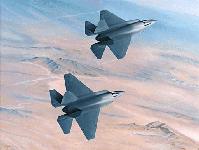



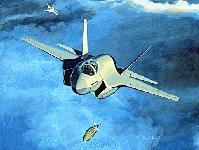

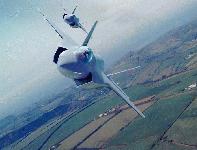
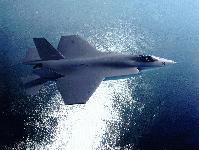
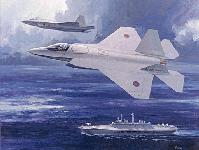
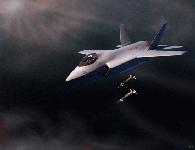
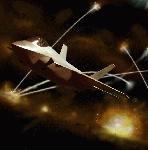

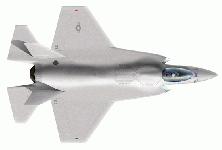
Boeing JSF Design - X-35
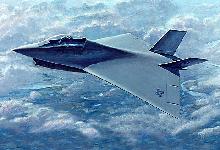
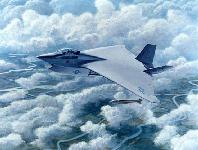
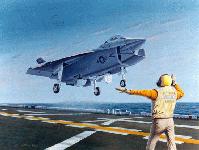
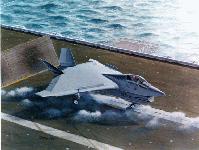
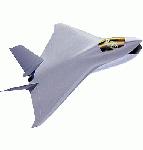
Specifications
|
| Function |
strike fighter
|
| Contractor |
two competing teams:
Lockheed-Martin
Boeing
|
| Service
|
U.S. Air Force
|
U.S. Marine Corps
U.K. Royal Navy
|
U.S. Navy
|
| Variants
|
Conventional Takeoff and Landing (CTOL)
|
Short Takeoff and Vertical Landing (STOVL)
|
Carrier-based (CV)
|
| Unit Cost FY94$
| $28M
| $35M
| $38M
|
| Propulsion
| Baseline: Pratt & Whitney F119-PW-100 derivative from F-22 Raptor
Alternate Engine: General Electric F120 core
|
| Thrust
|
|
|
|
| Empty Weight
| ~22,500 lbs
| ~24,000 lbs
|
| Internal Fuel
| 15,000 lbs
| 16,000 lbs
|
| Payload
| 13,000 lbs
| 17,000 lbs
|
| Maximum Takeoff Weight
| ~50,000 lbs
|
| Length
| 45 feet
|
| Wingspan
| 36 feet
| 30 feet
|
| Height
|
|
|
|
| Ceiling
|
|
|
|
| Speed
| supersonic
|
| Combat Radius
| over 600 nautical miles
|
| Crew
| one
|
| Armament
|
|
|
|
| First flight
| 1999
|
| Date Deployed
| 2008
|
| Inventory Objectives
|
U.S. Air Force
2,036 aircraft
|
U.S. Marine Corps
642 aircraft
U.K. Royal Navy
60 aircraft
|
U.S. Navy
300 aircraft
|
Sources and Resources
- Dave Hasting's JSF Page
- Joint Adv Strike Tech Program FY98 R&D Budget Request
- 0603800N JOINT ADVANCED STRIKE JASTP FY98 R&D Budget Request
- The Joint Strike Fighter Derek W. Avance; Christopher S. Ceplecha; Robert E. Clay; Terry M. Featherston; David S. Grantham; Thomas E. Gregory (Faculty Advisor); Patrick A. Kelleher; David Kelly; Thomas L. Moore (Faculty Advisor); Garry L. Pendleton; John Rupp; Christopher E. Yelder Air Command and Staff College 1996
- JSF excerpts from House National Security Committee Report on House National Defense Authorization Act for FY 1998
- MEMORANDUM FOR CORRESPONDENTS June 23, 1998
The Joint Strike Fighter program office today announced today that Pratt & Whitney began ground testing the second of two developmental engine designs for the Joint Strike Fighter (JSF) Concept Demonstrator Aircraft (CDA).
- Designing The Next Generation Strike Fighter Brigadier General Leslie Kenne, Director, Joint Strike Fighter Program Office [1500k PDF]
- Boeing Refines Joint Strike Fighter Design
February 4, 1999 - Boeing has taken the next step in maturing the design for its Joint Strike Fighter (JSF), improving its affordability, supportability and performance capabilities while maintaining the fundamentals of its original weapon-system concept.
- Joint Strike Fighter concept demonstrators slated to begin flying Air Force Print News 24 May 2000 -- Competitors for the Air Force's newest multi-role aircraft, the Joint Strike Fighter, will begin flying their concept demonstrators in the next few months.
- Joint Strike Fighter Acquisition Strategy, Boeing Press Release, 22 June 2000 -- Boeing supports today's Defense Department announcement confirming the current winner-take-all strategy on the Joint Strike Fighter competition.
- Cohen: Joint Strike Fighter program must stay on schedule, Stars and Stripes, 24 June 2000 -- Defense Secretary William Cohen sent a letter to senior House and Senate lawmakers Thursday urging them to keep the funding and schedule for the Pentagon's Joint Strike Fighter aircraft on schedule.
- First Joint Strike Fighter lands at Edwards, Air Force Print News, 20 September 2000 -- One version of the Joint Strike Fighter program made its first flight early Sept. 18.
- NAVAIR test pilot breaks new ground in JSF testing, NAWCAD Public Affairs, 26 October 2000 -- In what could be the one of the last "first flights" of a new fighter program for a long time, Boeing chief test pilot Fred Knox piloted the X-32 Joint Strike Fighter concept demonstrator on its first flight thrilling none more than Navy Cmdr. Phil "Rowdy" Yates.
- The Lockheed Martin Joint Strike Fighter X-35A successfully executed a series of airborne refuelings during its 10th flight, demonstrating the aircraft's flying qualities during refueling and paving the way for extended test flights., Air Force Print News, 15 November 2000 -- The Lockheed Martin Joint Strike Fighter X-35A successfully executed a series of airborne refuelings during its 10th flight, demonstrating the aircraft's flying qualities during refueling and paving the way for extended test flights.
- Boeing X-32A begins simulated carrier-landing tests, Air Force Print News, 17 November 2000 -- The Boeing Joint Strike Fighter X-32A concept demonstrator aircraft began field carrier-landing practice tests Nov. 15 to demonstrate flying and handling qualities during low-speed aircraft carrier approach.
- X-35A breaks sound barrier, Air Force Print News, 27 November 2000 -- With its flight testing now complete, the X-35A returned to Lockheed Martin's nearby Palmdale, Calif., facility to be fitted with a shaft-driven lift-fan propulsion system. It will be renamed the X-35B and will begin ground testing in preparation for its short takeoff/vertical landing demonstrations.
- Navy Variant of Lockheed Martin JSF Takes Flight, Lockheed Martin Press Release, 16 December 2000 -- The United States Navy version of the Lockheed Martin Joint Strike Fighter (JSF) demonstrator took to the skies on Saturday, Dec. 16, initiating a flight-test program that will focus on carrier-suitable flying qualities and aircraft performance.
- Boeing Completes JSF X-32B Engine Accelerated Mission Tests, Boeing Press Release, 15 January 2001 -- Boeing, Pratt & Whitney and Rolls-Royce today completed accelerated mission tests of the Joint Strike Fighter X-32B qualification engine at Pratt & Whitney's facility in West Palm Beach, Fla.
- U.S., U.K. Sign Joint Strike Fighter Agreement Jan. 17, U.S. Department of Defense, 17 January 2001 -- Deputy Defense Secretary Rudy de Leon signed a U.S.-United Kingdom Memorandum of Understanding on the joint strike fighter (JSF) with Baroness Symons of Vernham Dean, U.K. Minister of State for Defence Procurement, in a ceremony at the Pentagon January 17.
- U.S., UK Defense Officials on Joint Strike Fighter Jet, U.S. Department of Defense, 17 January 2001 -- The United States and the United Kingdom signed an agreement on the Joint Strike Fighter military aircraft (JSF) at a ceremony January 17 at the Pentagon.
- Boeing Completes JSF X-32B Maximum-Thrust STOVL Engine Runs, Boeing Press Release, 08 March 2001 -- Boeing yesterday completed maximum-thrust engine runs in the short-takeoff-and-vertical-landing (STOVL) mode on its Joint Strike Fighter X-32B concept demonstrator, achieving a major milestone in preparation for first flight.
- Boeing JSF X-32B Completes Successful First Flight, Boeing Press Release, 29 March 2001 -- The Boeing Joint Strike Fighter X-32B demonstrator today successfully completed its first flight, entering a four-month test program to validate the Boeing direct-lift approach to short-takeoff-and-vertical-landing (STOVL) flight.
- Joint Strike Fighter Agreement Signed , DOD News Release, 06 June 2001 -- Officials from Pratt & Whitney (P&W) and GE Aircraft Engines (GEAE) today signed an agreement to work together on the Joint Strike Fighter (JSF) program, to assure that both companies' engines will be physically and functionally interchangeable across all three variants of the JSF aircraft.
- Joint Strike Fighter Homepage - Air Force
- Lockheed Martin JSF Homepage
- Boeing JSF Homepage
- DOD News Briefing -- Joint Strike Fighter Development Selection - Nov. 16, 1996
- Joint Strike Fighter Armed Forces Journal International, February 1996
- Politics could cloud fighter plane's future Fort Worth Star-Telegram
(Jun 24, 1996)
http://www.fas.org/man/dod-101/sys/ac/jsf.htm
Maintained by Robert Sherman
Originally created by John Pike

 The Lockheed Martin X-35 concept for the Marine and Royal Navy variant of the aircraft uses a shaft-driven lift-fan system to achieve Short-Takeoff/Vertical Landing (STOVL) capability. The aircraft will be configured with a Rolls-Royce/Allison shaft-driven lift-fan, roll ducts and a
three-bearing swivel main engine nozzle, all coupled to a modified Pratt & Whitney F119 engine that powers all three variants.
The Lockheed Martin X-35 concept for the Marine and Royal Navy variant of the aircraft uses a shaft-driven lift-fan system to achieve Short-Takeoff/Vertical Landing (STOVL) capability. The aircraft will be configured with a Rolls-Royce/Allison shaft-driven lift-fan, roll ducts and a
three-bearing swivel main engine nozzle, all coupled to a modified Pratt & Whitney F119 engine that powers all three variants.

 The Boeing X-32 JSF short takeoff and vertical landing (STOVL) variant for the U.S. Marine Corps and U.K. Royal Navy employs a direct lift system for short takeoffs and vertical
landings with uncompromised up-and-away performance.
The Boeing X-32 JSF short takeoff and vertical landing (STOVL) variant for the U.S. Marine Corps and U.K. Royal Navy employs a direct lift system for short takeoffs and vertical
landings with uncompromised up-and-away performance.





















